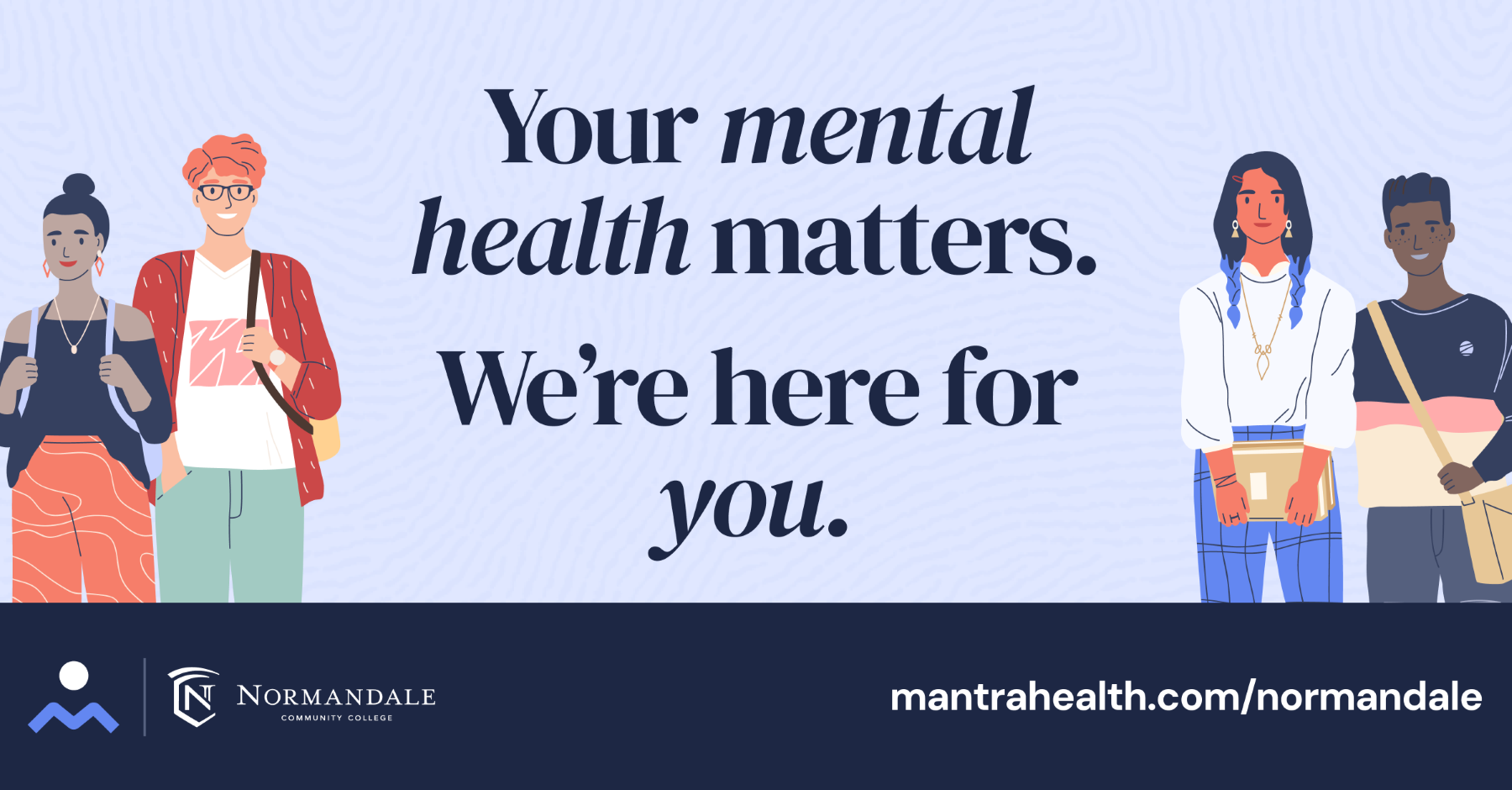
Dial 988 for the Suicide and Crisis Lifeline If you are experiencing a mental health crisis.
College can be some of the best days of your life, but it can also be a stressful time. Normandale's counseling and mental health team can help you develop healthy ways to cope with concerns that may come up as you pursue your education.
We offer free, confidential counseling and mental health appointments on campus, over Zoom or by phone to currently enrolled students. Schedule an appointment online, or call 952-358-8261 for assistance.

Make an appointment
she/her/hers
Approach to Counseling, Mental Health and Professional Interests
I seek to help students realize they are not alone in the challenges they face as college students and as humans. Stress, anxiety, sadness, grief, loss, relationship challenges, and other mental health issues can feel overwhelming and isolating. By using a variety of counseling modalities and culturally competent counseling, I help students normalize their experiences, gain helpful perspective, and adopt healthier ways of thinking and behaving. My approach is strengths-based and solution-focused. I often utilize Cognitive Behavioral Therapy techniques that look at how our thinking and beliefs impact our emotions and actions. I have been certified in Trauma-Informed Counseling and Accelerated Resolution Therapy (ART), which is a brief therapeutic approach that uses eye movements to process challenging experiences.
Career and college major indecision can also impact mental health and wellbeing. As someone who struggled with deciding on my major and career, I can empathize with students who experience anxiety related to such decision-making. I enjoy helping students with these explorations and decisions.
Counseling topics I specialize in include stress, anxiety, grief/loss, trauma, life transitions, sadness, and relationship challenges.
In previous roles I worked with students in TRIO/Upward Bound, and enjoy working with first-generation college students.
Personal Interests
I enjoy time in nature hiking, running, cycling, and gardening. I play the oboe in local community ensembles and at my church and have enjoyed taking art and music classes at Normandale. Reading fiction and international travel are also favorite pastimes.
Education
License and Certification
Licensed Professional Counselor (LPC) with the State of Minnesota
Accelerated Resolution Therapy (ART) certification
National Certified Counselor
Global Career Development Facilitator
Certified Mental Health First Aid trainer

Make an appointment
she/her/hers
Approach to Counseling, Mental Health and Professional Interests
My number one priority to a student seeking counseling is to present a “safe” space, whether it be in person or virtually. I want them to know that it’s okay to be vulnerable; it’s okay to share from their heart. It is gratifying to help students recognize their strengths and how to utilize them to cope with daily stressors. I also enjoy helping students realize how their thoughts, feelings and behaviors are interconnected and how changing their thinking can greatly reduce their stress. An area that I am striving to learn more about is suicide education and prevention. I have been trained in Accelerated Resolution Therapy (ART), helpful for individuals dealing with trauma.
Personal Interests
My favorite pastime is reading novels, especially mysteries. During my personal time, I enjoy seeing movies, plays and musicals with family and friends, and I love to travel. I find nature walks and yoga both energizing and relaxing. I derive great satisfaction from volunteering with an agency that strives to provide education on mental health and reduce the stigma around mental health challenges.
Education
Licenses and Certifications
Licensed Professional Counselor (LPC) with the State of Minnesota
Certified Mental Health First Aid trainer

Make an appointment
he/him/his
Approach to Counseling, Mental Health and Professional Interests
Just as I have been guided by many “coaches” in my life, as a counselor, I work to “coach” students toward understanding themselves to a greater degree so that the decisions and choices made while in college lead to personal growth, satisfaction and minimal regret. Decisions about majors, careers, relationships, and health can all be enhanced when one can clearly see who it is they are becoming. My goal is to facilitate these decisions.
When the decisions are difficult, emotions can get strained and out of balance. I work to guide students through difficulties using an eclectic approach based in non-judgmental, unconditional acceptance and encouragement. Among the various counseling methods that I use, Dialectical Behavior Therapy (DBT) is the most recent one for which I have completed training. I have also received focused training on Grief and Loss, Multi-cultural competence, Under-resourced students, and “Strengths”.
I can be expected to support and promote effective transitions, emotional self-management, healthy relationships, and maximizing academic performance. I provide guidance and encouragement to all Normandale students for achieving their success.
Personal Interests
When I am not wearing my counselor hat, I strive to keep physically and emotionally fit. I balance my time between recreation and relaxation- hiking, cooking, gardening and fantasy baseball are activities that I enjoy.
One of my favorite quotes that guides my counseling is taken from Shakespeare’s Hamlet: “This above all: to thine own self be true.”
Education:

Make an appointment
she, her, hers
Approach to Counseling, Mental Health, and Professional Interests
I’ve been a part of the faculty counseling staff at Normandale since 1992. Although I have many years in the field each student brings their own individual challenges and that’s what makes my job interesting daily. My Specialties: Personal counseling, Advising, and Teaching success strategies for college students and adults. Passionate about first-generation and students of color.
Education
BBA, University of Central Arkansas
MS, University of Central Arkansas
License and Certifications
Mental Health First Aid certified
Make an appointment
she, her, hers
Approach to Counseling, Mental Health, and Professional Interests
I enjoy having conversations with people about their education, career, and life ambitions, helping them to identify their interests, values, and strengths, and partnering with them to create a plan to achieve their goals. I strive to create an environment where people feel safe and respected. During our first meeting, will ask what prompted you to make the appointment. I will listen and ask questions to get a better understanding of your situation. I will offer encouragement, empathy, and humor where appropriate. I may refer you to other resources or offer therapeutic activities for you to try. Some people get what they need from this first meeting, while others opt to meet again. After the initial session, I use a collaborative approach where I ask what will be the most helpful for you during our time together and what you would like to achieve. I will not have all of the answers; however, I’ll do my best to point you to other perspectives and strategies that you may want to consider. My wish is for you to walk away feeling heard, hopeful, and empowered.
Counseling topics I specialize in include: grief and loss, navigating change, career/purpose, job concerns, self-compassion, stress management, school concerns, coping with a medical diagnosis, philosophical concerns, and loneliness.
Personal Interests
Outside of work I care for myself by listening to music, spending mindful moments outdoors, giving attention to my sweet dogs, writing, reading, and talking and laughing with my many mutually supportive friends.
Education
License and Certifications
Licensed Professional Clinical Counselor (LPCC)
Certified Grief Informed Professional

Make an appointment
she/her/hers
Programs
Individual therapy, assessment, consultation, and crisis intervention
Approach to Counseling, Mental Health and Professional Interests
I utilize a collaborative, integrative approach to therapy, honoring that the student is the expert in their own life. I enjoy helping each individual find their strengths and passions to help them manage emotional and mental health issues as they reach their academic goals.
Education
All students who schedule therapy appointments will be required to review and submit a signed Informed Consent for Psychological/Mental Health Services form.
During your first appointment, we want to learn about you, any personal challenges you may be experiencing, and any mental health concerns you may have. Many students report feeling better after the first appointment.
It's natural to feel nervous before a first counseling appointment. You're encouraged to be open and honest and ask questions if you have them. And, if you're not sure where to start, it's ok. We'll help by asking you some questions, too.
We are here to help. Schedule an appointment online, or call 952-358-8261 for assistance.
We’re thrilled to partner with digital mental health provider Mantra Health to bring students diverse, high-quality mental health support via the Care Hub.

Call the Suicide and Crisis Lifeline at 988 or visit your nearest emergency room if you’re currently in a life-threatening situation or your safety is at risk.
Normandale counselors make every effort to accommodate your urgent needs. If you are on campus and experiencing a crisis, you can come to the Advising, Counseling & Career Center in College Services 1115, or call Public Safety 952-358-8280.
If it is after hours, please consider using the 24/7 crisis resources in case of an emergency.
988 Suicide and Crisis Lifeline provides free and confidential emotional support to people in suicidal crisis or emotional distress 24/7.
Crisis Text Line is free, confidential and available 24/7.
COPE: Mobile Crisis Response: The Cope mobile crisis team can come to where you are. Cope responds to anyone in Hennepin County who needs an urgent response, and has bilingual staff available for face-to-face, phone and video visits. Call 612-596-1223.
The Trevor Project provides support for LGBTQ youth, available 24/7.
Bloomington Police have licensed social workers on staff who can assist with mental health emergencies. Please share that you are having a mental health emergency when calling.
In a crisis, you can also go to your nearest emergency room for help.
The resources listed provide information and give ideas for self-care. You are encouraged to seek counseling to discuss any of these concerns.
Content is for informational and educational purposes only. Our website is not intended to be a substitute for professional medical advice, diagnosis, or treatment. The Advising, Counseling, and Career Center at Normandale Community College does not assume responsibility for the quality of services provided by mental health agencies or web sites listed. Inclusion in the list does not imply endorsement nor does omission indicate disapproval.
This online mental health screening tool is designed to provide a safe, anonymous way for you to check in on your mental health. This self-assessment allows you to screen yourself for a variety of mental health concerns including mood, anxiety, eating, and alcohol use concerns. It can tell you if your results are consistent with a mental health concern, give you an overview of the signs and symptoms of treatable mental health concerns, and provide access to educational and self-help resources.
Your results are anonymous. You are encouraged to schedule an appointment with a Normandale counselor or licensed clinical psychologist if you would like to talk about your results.
The resources listed below provide information about mental health and substance use disorders. You are encouraged to seek counseling to discuss any of these concerns.
The Advising, Counseling and Career Center at Normandale Community College does not assume responsibility for the quality of services provided by outside agencies or websites shared. Inclusion in the list does not imply endorsement nor does omission indicate disapproval.
Normandale's Student Resource Center strives to strengthen the supportive network that helps students meet their current and long-term needs and goals. The center connects students to campus and community resources and services to help them overcome barriers that interfere with their academic success.
Room C 1115
Hours: M, T, W: 8 am - 5 pm, Th 10 am - 5 pm F 8 am - 4:30 pm
 top
top